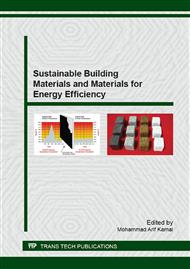[1]
Givoni.B. (1989) Urban Design in Different Climates, WCAP-10, World Meteorological Organization, Geneva.
Google Scholar
[2]
Yencken, D. (1993) Design in Australia, quoted in Competing by Design: The National Design Review Report (1995), National Design Review Steering Committee, The Australian Academy of Design, Sydney.
Google Scholar
[3]
Evyatar, David Pearlmutter and Terry Williamson, 2011 Urban Microclimate - Designing Spaces Between Buildings.
Google Scholar
[4]
T.R. Oke, G.T. Johnson, D.G. Steyn and I.D. Watson, Simulation of surface urban heat islands under "ideal" conditions at night - Part 2: Diagnosis and causation, Boundary Layer Meteorology, Vol. 56, pp.339-358 (1991).
DOI: 10.1007/bf00119211
Google Scholar
[5]
Microclimatic landscape Design – Creating Thermal Comfort and Energy Efficiency by Robert D. Brown and Terry J. Gillespie p.1.
Google Scholar
[6]
Microclimatic landscape Design – Creating Thermal Comfort and Energy Efficiency by Robert D. Brown and Terry J. Gillespie p.45.
Google Scholar
[7]
Taylor, R.A., Socioeconomic impacts of heat transfer research, International Communications in Heat and Mass Transfer Volume 39, Issue 10, December 2012, Pages 1467–1473.
DOI: 10.1016/j.icheatmasstransfer.2012.09.007
Google Scholar
[8]
World Commission on Environment and Development (WCED). Our Common Future. Oxford: Oxford University Press, 1987 p.43.
Google Scholar
[9]
Sustainable Architecture Module: Qualities, Use, and Examples of Sustainable Building Materials, Jong-Jin Kim, Assistant Professor of Architecture, and Brenda Rigdon, Project Intern, 1998 p.16.
Google Scholar
[10]
Endre Dobos University of Miskolc, Miskolc-Egyetemva´ros, Hungary.
Google Scholar
[11]
M. Santamouris, N. Papanikolaou, I. Livada, I. Koronakis, C. Georgakis, A. Argiriou, and D.N. Assimakopoulos, On the impact of urban climate on the energy consumption of buildings, Solar Energy, Vol. 70, pp.201-216 (2001).
DOI: 10.1016/s0038-092x(00)00095-5
Google Scholar
[12]
Tan, S.A., Fwa, T.F., 1992. Influence of pavement materials on the thermal environ-ment of outdoor spaces. Build. Environ. 27, 289–295.
DOI: 10.1016/0360-1323(92)90030-s
Google Scholar
[13]
Akbari, H., Pomerantz, M., Taha, H., 2001. Cool surfaces and shade trees to reduce energy use and improve air quality in urban areas. Sol. Energy 70, 295–310.
DOI: 10.1016/s0038-092x(00)00089-x
Google Scholar
[14]
www. imd. gov. in - Indian Meteorological Department, Ministry of Earth Sciences, Government of India. (IMD).
Google Scholar
[15]
Significance of air movement for thermal comfort in warm climates: A discussion in Indian context, Madhavi Indraganti et. al , Proceedings of 7th Windsor Conference: The changing context of comfort in an unpredictable world Cumberland Lodge, Windsor, UK, 12-15 April 2012. London: Network for Comfort and Energy Use in Buildings.
Google Scholar
[16]
Höppe, P., 1984. Die energiebilanz des menschen. Dissertation. Wiss Meteorol, Inst. Univ. München.
Google Scholar
[17]
Höppe, P., 1994. Die wärmebilanzmodelle MEMI und IMEM zur bewertung der ther-mischen beanspruchung am arbeitsplatz. Dtsch. Ges. Arbeitsmed. Umweltmed. 34, 153–158.
Google Scholar
[18]
Matzarakis, A., Mayer, H., Iziomon, M.G., 1999. Applications of a universal thermalindex: physiological equivalent temperature. Int. J. Biometerol. 43, 76–84.
DOI: 10.1007/s004840050119
Google Scholar
[19]
Matzarakis, A., Endler, C., 2010. Climate change and thermal bioclimate in cities: impacts and options for adaptation in Freiburg, Germany. Int. J. Biometeorol. 54, 479–48.
DOI: 10.1007/s00484-009-0296-2
Google Scholar
[20]
Microclimate Studies for Sustainable Public Housing Development, John NG Housing Department Hong Kong SAR Government.
Google Scholar


